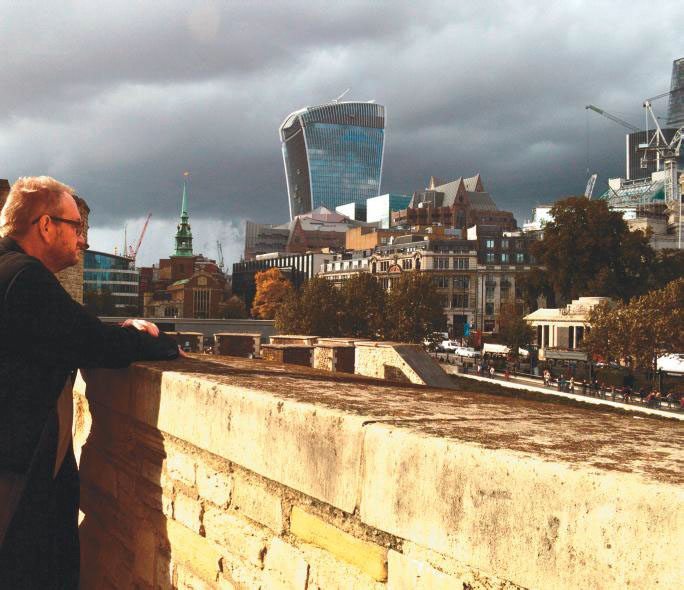
THIS MONTH HAS BEEN ONE of views and vistas, long, short, high, low—spectacular all. For instance, take the newly opened North Wall Walk along the Tower of London’s ramparts, to which I dragged my pal on a fitfully stormy day of dark clouds and dazzling gaps of sunshine. The battlements are centuries old, but used to be out of bounds. Now the stretches between towers Bowyer and Flint are accessible, with two small, interesting exhibitions; about the Duke of Wellington, and the Tower’s role in World War I.
You don’t get a direct look down into the moat; although from the outside it looks solid, the Tower’s builders were taking no chances. There are actually two gigantic walls, and the view from the new, inner rampart is two-fold. The curious “Gotham-City-esque” vista of the City’s skyscrapers is invigorating. But you also get to look down on a mysterious other world, where people who live in the Tower (Yeoman Warders and their families) have quaint cottages built into the thick walls, complete with little container gardens, roof-top barbeques and washing lines. Who could fail to be fascinated by a secret village, within a city, that literally locks itself behind massive wooden gates every night?
ONE OF THE MOST SURPRISING church views lies a stone’s throw from the Tower. St. Dunstan’s in the East, damaged in the Great Fire and patched up by Sir Christopher Wren, did not outlive Adolf Hitler. Its flanks and tower survived, but nothing else. The City of London chose to keep it as a ruin and turn it into a garden for the people of the parish. Laid out by the Worshipful Company of Gardeners, it opened in 1971, and 40-odd years on it has been clad in creepers, giant fatsias and palms shading a quiet central pool. Despite being not five minutes from London’s biggest tourist attraction, “the Gardeners’ Church” is almost unknown, save by the odd City worker enjoying a lunchtime sandwich; a beautiful, secret oasis.
If you walk down to the church via St. Dunstan’s hill, don’t miss the Peek “Camels,” a small, deep-relief panel over the door of 20, Eastcheap. Modeled in 1884 by sculptor William Theed, they were the trademark of Peek Brothers, a Victorian trading company. The Arabian trader’s three dromedaries depicted carry loads representing Peeks’ main products: tea, coffee and spices.
[caption id="" align="alignright" width="327"]
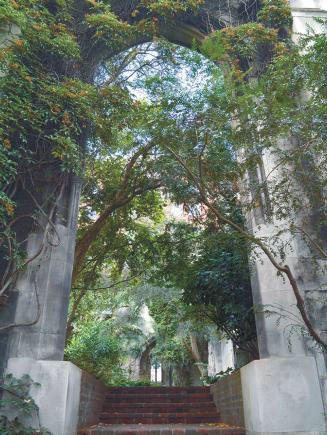
JUST ALONG THE ROAD from the Metropolitan Archives lies trendy Exmouth Market. Once a scruffy thoroughfare of tatty market stalls and shops selling plastic buckets, now it’s the center of a foodie revolution. In between the two lies a fabulous new eaterie, Bourne & Hollingsworth Buildings. Managing to straddle wine bar and country-house party, it specializes in food of the moment. The menu changes on a dazzlingly regular basis, refecting whatever’s in season at London’s various markets on the day.
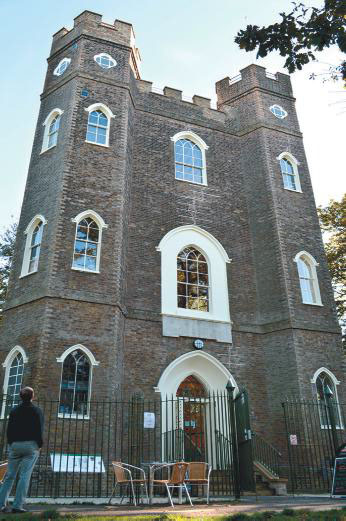
For More Information
North Wall Walk, Tower of London
www.hrp.org.uk
St. Dunstans in the East St. Dunstan’s Hill, EC4
open daily 8 a.m.-dusk.
Peek Camels – Peek House, 20 Eastcheap, EC3
Bourne and Hollingsworth Buildings
www.bandhbuildings.com
Knitting and Stitching Show
www.theknittingandstitchingshow.com and cross your fingers—good luck!
Severndroog Castle
www.severndroogcastle.org.uk
My friend Frances and I sat in the greenhouse; light and airy with glasspaned roof and white painted walls, like a forgotten orangery. The jasmine-twined wrought ironwork, hanging ferns, date palms and orchids might have been brought back from the tropics in a Wardian case by Great Uncle Arbuthnot, and to sip champagne from glass saucers felt as decadent as though I was actually there with him. Our autumn-based fare riffed on the English harvest: Hazlenuts, squash, rabbit, freshly picked mushrooms and seasonal chutneys. Next time, I will see a completely different melange of flavors.
I’m a keen crafter: sewing, knitting and making things from old junk I find in skips. And there’s nothing I enjoy better than the inspiration I find from the Knitting and Stitching Show. It’s huge; hundreds of exhibitors, retailers and manufacturers come to show off their wares, from little country market stallholders to massive international sewing machine companies.
The London show is held twice a year; at Olympia in the spring, and historic Alexandra Palace in the fall. I adore Ally Pally, high on a hill north of the city and boasting views across to Kent and Surrey. Even the journey’s lovely—either a short tube trip and free shuttle bus, or a minor train ride and brisk walk through the park and autumn leaves. I spend the day getting lost among stalls of ribbons, buttons, laces, strange gadgets, designer fabrics and yarn bales at knockdown prices. There are exhibitions of exquisite handwork, fashion shows and technique classes, but just wandering around the stalls, seeing what’s new, and letting my imagination soar, is all I need to walk away inspired for the long winter nights.
WHEN COMMODORE SIR WILLIAM JAMES, gung-ho commander in chief of the East India Company, married Anne Goddard in 1759, it’s likely she overlooked the fact that he was almost twice her age. Money probably had something to do with it, but she was also dazzled by something else: his victory over pirates in the Indian fortress of Severndroog four years earlier. He was a celebrity. When her husband finally passed away, inconveniently during their daughter’s marriage feast, Anne was so keen to preserve his memory, she built a gorgeous tower at the top of London’s highest hill. Severndroog Castle, a fabulous gothic fantasy with two exquisitely paneled rooms, was for taking tea with Anne’s friends, showing off memorabilia of James’ career and taking visitors to the roof for panoramic views of London from Shooters Hill.
The centuries weren’t kind to Severndroog. It fell into disrepair, and one of London’s last remaining prehistoric woodlands, Oxleas, took over. Enveloped by trees, shaken by subsidence and defaced by vandals, a couple of years ago Severndroog was a sorry sight. But—hooray for the Heritage Lottery Fund! HLF matched local fundraisers’ efforts with hard cash and after extensive conservation, the tower is pristine and boasts a teeny-tiny tearoom with a view that Anne James would have known. On a clear day, you can see Windsor Castle from this hill; certainly Wembley, St. Paul’s and Alexandra Palace are easy sights. I’m assured that when the trees lose their leaves it is even more staggering. I can’t wait.





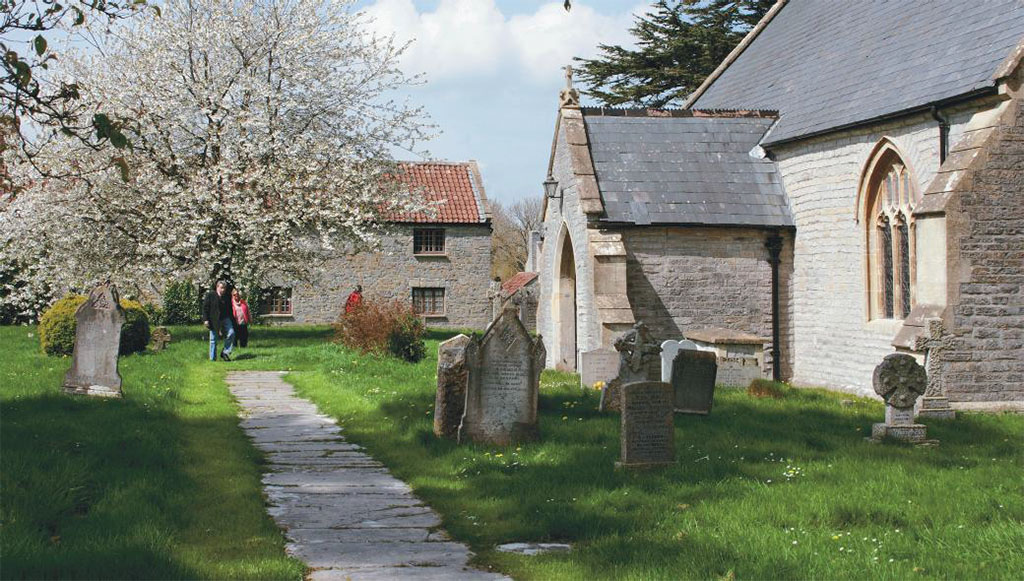
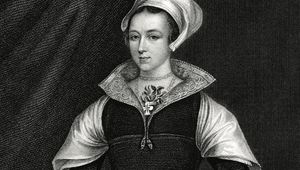

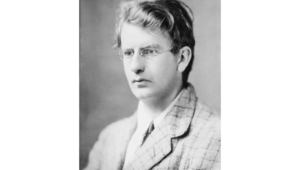
Comments